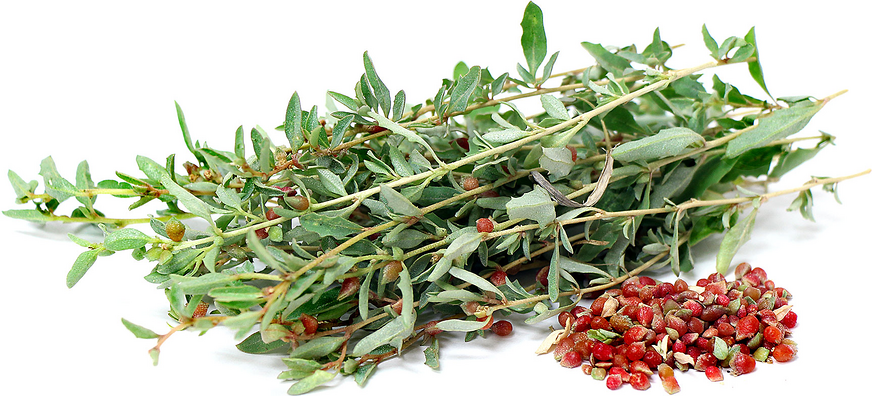


Saltbush Berries
Estimated Inventory, oz : 0
Description/Taste
Saltbush berries are small fruits that grow on dense, low-lying mats of foliage. These berries have a rounded, teardrop shape, similar to a pomegranate seed but with a pointier tip. They measure about 4 to 6 millimeters in size and have a bright red-orange hue dusted with a white residue. Saltbush berries are glossy yet slightly shriveled, with a texture resembling dried jelly. They have a juicy flesh that surrounds crunchy black or brown seeds, which are about 1.5 to 2 millimeters in size. The berries have a tart cranberry flavor with a distinct saltiness and fresh, grassy undertones. The gray-green leaves of Saltbush plants are also edible and share the berries' salty nature.
Seasons/Availability
Saltbush berries are available from spring to early summer.
Current Facts
Saltbush berries are botanically classified as Atriplex semibaccata and belong to the Amaranthaceae family, which also includes beets, quinoa, chard, and spinach. This species is also referred to as Australian Saltbush, Creeping Saltbush, and Scrambling Saltbush berries. The bush these berries grow on forms a mat-like shape with low-growing, sprawling branches covered in leaves. It only reaches a height of 40 to 80 centimeters but spreads out 1.5 to 2 meters wide. Saltbush berry plants provide food and shelter to many creatures including skinks, frogs, birds, pygmy blue butterflies, and grazing animals. While the plant has several culinary uses, it is primarily grown for its ornamental and practical benefits rather than for its berries.
Nutritional Value
The nutritional value of Saltbush berries is not widely known, but the leaves and seeds of the plant have been historically used as a source of protein. These nutrients aid in muscle growth and repair, hormone production, cell and tissue growth, immune support, and energy, keratin, and collagen production for healthier skin, nails, and hair. The plant is often consumed by lambs that graze on it, which results in their meat being milder, less gamey, and higher in vitamin E. This vitamin aids in wound healing, cell regeneration, and eye health, and helps prevent free radical cell damage, bad cholesterol levels, inflammation, and sun damage. The oils extracted from Saltbush berry leaves possess antibacterial and antioxidant properties that may enhance the effectiveness of the antibiotic gentamicin in combating infections.
Applications
Saltbush berries can be used on their own or the leaves can be dried for seasonings. The raw berries can be tossed into salads, couscous, granola, yogurt parfaits, or charcuterie boards to add a tart, salty flavor. They can also be preserved in jams, jellies, and chutneys. These berries may be incorporated into smoothies, tarts, cakes, sorbets, and fruit sauces. Dried Saltbush berry leaves have an inherent salinity that makes them a natural complement to seafood. The entire bush may be laid over a bed of coals to grill beef, pork, or lamb. As the branches and leaves char, they impart a smoked saltiness to the meat as it cooks. Saltbush berries pair well with the flavors of goat cheese, ricotta, brie, farro, chicken, pork, dried fruits, oranges, almonds, walnuts, pistachios, dark chocolate, balsamic and apple cider vinegar, cinnamon, ginger, and cardamom.
Ethnic/Cultural Info
Saltbush berries are a bush tucker, a variety of wild food native to the lands of Australia. Bush tucker was historically used by Indigenous Australians during the hunter-gatherer societies that were developed before colonial settlers arrived there. These tribes would forage for nutrient-rich crops like the Saltbush berry plant along with other herbs, spices, nuts, seeds, and fruits. They also hunted crocodiles, emu, and kangaroos as these were good sources of protein. Indigenous peoples developed an extensive knowledge of edible crops and plants, which they passed down through generations to ensure their survival. Today, many of these native bush ingredients are used in natural medicine and skincare.
Geography/History
Saltbush berries are native to West and South Australia, Queensland, Victoria, and New South Wales. They are a drought-tolerant species that thrives in sandy and clay loam soils and are able to endure hot, barren climates but often die back during the driest summer months. Saltbush berries can grow wild in saline flats, wastelands, disturbed areas, roadsides, marshes, the edges of salt lakes, and woodlands. These fruits were introduced to many regions worldwide as a drought and salt-tolerant fodder crop, starting in Tasmania, Australia, and later spreading to Africa, the Middle East, the Arabian Peninsula, and Southern Europe. Saltbush berry plants were introduced to California as livestock feed for animals in salty soils, and they were later distributed throughout Baja California before eventually reaching Chile. These berries are typically foraged from the wild rather than bought in stores or grown in home gardens.
Recipe Ideas
Recipes that include Saltbush Berries. One
| Good Food |
|
Gravlax Cured with Desert Lime and Saltbush |
| Bush Tucker recipes |
|
Onion Pie |
| Bush Tucker recipes |
|
Saltbush & Native Basil Salsa |




